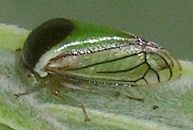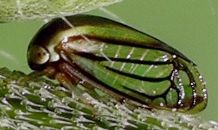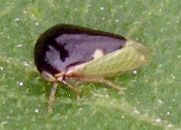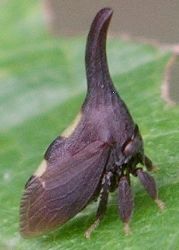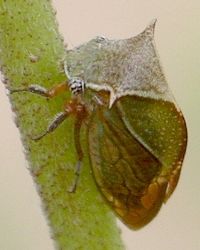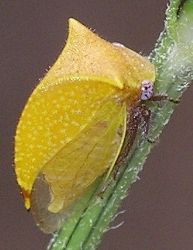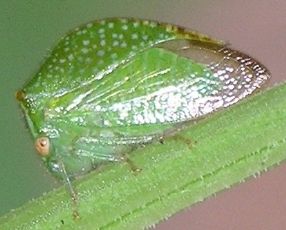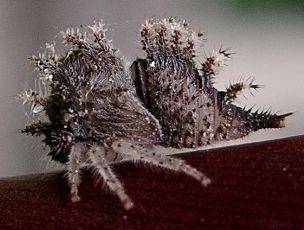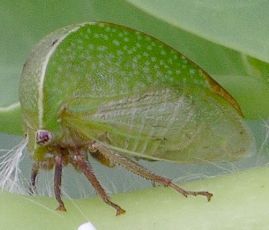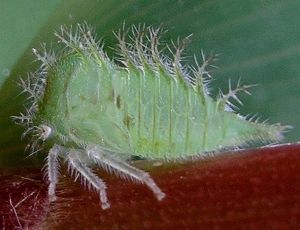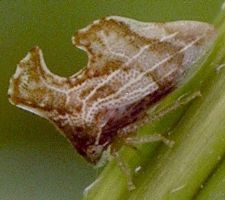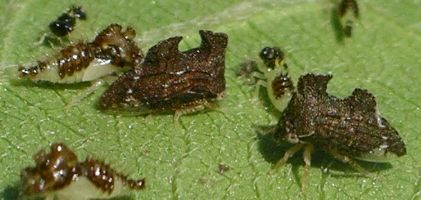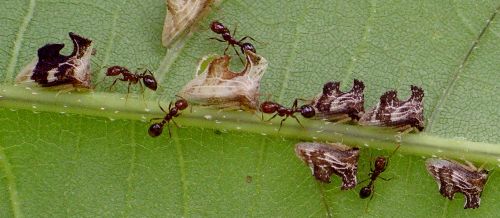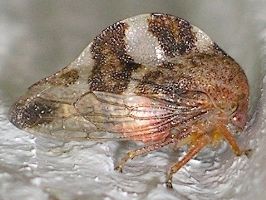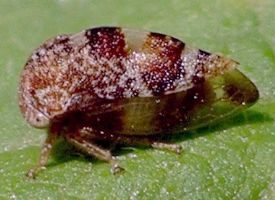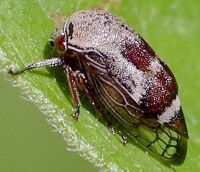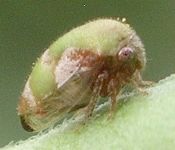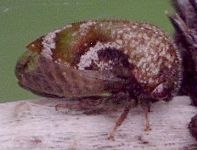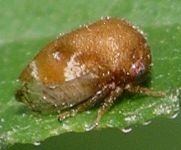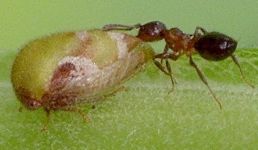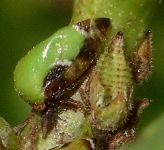
| Membracidae ~ Treehoppers |
|
All species within this family are very small, the largest being only about 6-7 mm in length. However, they are spectacular little creatures, having a huge variety of forms, the most well-known of which mimic thorns on a branch. Membracids are commonly called treehoppers, and many do feed on trees. They are rarely numerous enough to do a lot of damage, though. Treehoppers can be found on the stems of plants, or on leaves, sometimes on the underside.
Identification to family is easy, as the extended pronotum (looks like a hood that extends from the head over the back) is distinctive. In spite of this large structure, most of these insects can fly, although they prefer to remain still and rely on their cryptic shape and color to protect them. Even getting to the genus level is a bit tricky, and figuring out species in most cases is beyond me. There can be color variability within species, but sometimes very small differences are all that separate one species from another.
Species in the genus Acutalis are only about 3 mm long and are shiny with various amounts of black on their pronotum. The rest of their body is light green and their wings have black veins. There is an even smaller species that resembles them, in the genus Micrutalis. Besides being smaller, it lacks the black wing veins.
On the larger side for this family, Enchenopa binotata is one of the few treehoppers I've been able to identify to species. I haven't seen many of them, but they are quite easy to recognize. Some treehoppers have two "horns" on their front. This is one of the more confusing groups, as they seem to be either in the genus Ceresa or Stictocephala, depending on which reference is used, and there are quite a number of species. These treehoppers come in different colors, including a beautiful yellow. The nymphs are spiky and even have spines coming out of their eyes!
Another rather large treehopper (if 6 mm can be considered large) is Spissistilus. This might be Spissistilus festinus, or the Three-cornered Alfalfa Treehopper, or it could be another species in the same genus. These have spiky nymphs, too. I've usually found this species on Prickly Pear Cactus or euphorbias.
Entylia concisa is obvious because of the two flattened projections that emerge from their back ridge, like distorted Bactrian camel humps. There are large and small individuals, as well as dark and light ones, and the differences might be simple variation or gender-related. Sometimes the large and small ones are together. This is one of the more socially inclined treehoppers, almost always being seen in groups that often include nymphs. They are sometimes accompanied by ants, which are after the honeydew that the treehoppers excrete as a byproduct of their feeding on plants. Because the ants move around more and are recognizable for what they are, it is a nice clue to finding the more cryptic treehoppers.
There are some genera of membracids that are in the 3-4 mm range that look rather similar. They don't have distinctively shaped pronotums and they come in multiple colors. One such genus is Cyrtolobus, which has brown markings on a translucent whitish base. Cyrtolobus has a slight ridge that seems to vary from pretty high to rather low. This might be sexual dimorphism but I've never seen them mating and so cannot be sure.
Vanduzea is a confusing genus, which isn't too hard to recognize for its members' small size and slightly hairy appearance. However, the colors range from brown to green and markings can be different, making species designations with any certainty unlikely. Sometimes small groups of these insects occur and the colors usually all match. Nymphs might be present, too. Ants sometimes take advantage of the groups to harvest honeydew from these membracids. In fact, I've only seen ants attending to groups of treehoppers and never to single individuals, so the ants probably need a whole "herd" to make their efforts worthwhile.
|
![]()
